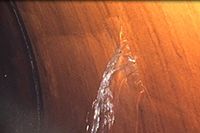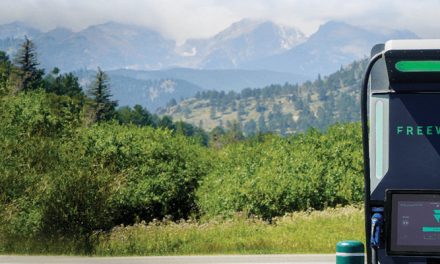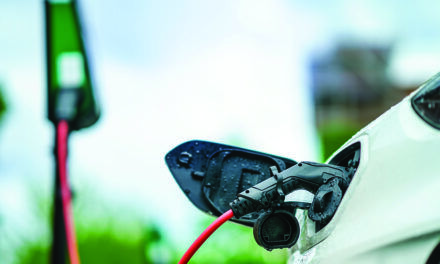
You can actually see using new video technology

Out of sight, out of mind.
Why guess when you can actually see using new video technology?
by: Peter Sutherland
In 2016, the EPA conducted a study to investigate the corrosion effects of storing ultra low sulphur diesel in underground tanks.
They conducted random internal video inspection of 46 tanks and identified that 83 per cent of steel tanks inspected showed significant corrosion.
There are several colloquialisms about the value of being able to see something. Sayings like “seeing is believing” or “you have to see it with your own eyes” describe the value of visual clues. I have a unique perspective on this after many years of reviewing precision leak test results on underground storage tanks with a technology that relies heavily on sounds created inside of a tank when you apply a vacuum. I would always be trying to imagine what a leak or hole in a tank looked like by the sound it produced. As I came to understand, cracked fibreglass tanks sound much different than a hole caused by corrosion of a steel tank. That is why I was so excited to see a new use of video technology that allowed you to see exactly what was happening inside of a storage tank, even being able to observe the inside of the tank while it was under vacuum. This allowed for conclusive visual verification of the size, location and nature of a leak. As it turns out that was only the tip of the iceberg in terms of what can be done with storage tank internal video inspection.
Cameras and borescopes have been commonly used for sewer and pipe inspections for many years. The problem with UST inspection has been sourcing a powerful light that could be used in an explosive environment. Now with high intensity LED technology this hurtle has been overcome. As the use of cameras has become more common in storage tanks we are discovering many things, some expected and others surprising.
In 2016, the EPA conducted a study to investigate the corrosion effects of storing ultra low sulphur diesel in underground tanks. They conducted random internal video inspection of 46 tanks and identified that 83 per cent of steel tanks inspected showed significant corrosion. This study showed that there is something surprising going on with steel and FRP tanks that contain ultra low sulphur diesel (ULSD). Brad Hoffman, an engineer involved in this study said: “I have been an engineer in the petroleum industry for my entire career, first with Exxon and for the last 23 years with Tanknology. I have never in my life seen corrosion of this magnitude in a fuelling system.” It is affecting steel as well as fiberglass tanks – attacking the metal components in the vapour space – bungs, risers, caps, plugs, STP shafts, ball float assemblies and flapper valves. The EPA is still trying to determine what is causing this corrosion. One theory is that when ethanol based fuels cross contaminate the ULSD fuel this may make the ULSD much more corrosive. Regardless of the cause, the scope of this problem could not have been discovered without the use of video inspection.
Another more common use of this technology is to identify and document leaks in tanks. This is useful either to assist in a warrantee claim or to know the most cost effective way to remedy the situation. Early in 2018, we found three separate cases of double walled tanks with a crack in the primary wall of the tank. In two of the cases a very small amount of brine was migrating into the tank over a period of weeks. The third crack that we discovered was in a tank with a dry annular space. This caused an intermittent bubbling sound when the tank was placed under vacuum and a slight pressure was created in the dry annular space. Testing and confirming these leaks took multiple site visits and significant downtime and lost revenue on the tanks. The pictures shown here highlight how easy these failures would be to identify by emptying the tank and using a video inspection while water or air was introduced into the annular space.
Another application of video inspection is during the tank cleaning process to verify that all areas of the tank have been cleaned. It is possible to actually watch the cleaning process while it is being conducted to give feedback and assist the cleaning technician to get all areas of the tank bottom.
The chemistry of vehicle fuel is always changing. In the recent past, this meant that when higher concentrations of ethanol were used in gasoline we saw compatibility issues with seals in pumps. We also saw that as more ethanol was added the gasoline now became much more soluble in water and led to unexpected problems when water entered storage tanks. When the fuels industry experimented with biodiesel fuel there were some severe compatibility issues with steel tanks. This process of constant change will continue into the future as retailers and regulators look for ways to make better and more environmentally acceptable fuels.
The common factor that is overlooked in the development of these new chemicals is the liquid handling equipment such as pumps, product lines and storage tanks. As has been found in the past it is likely that some of these innovative new fuels will not be compatible with the storage equipment but the tanks are buried and out of sight and out of mind. It is not realistic to assume that we can prepare for any possible outcome, but tools like video inspection should definitely be engaged to monitor for unexpected results and to be used as an effective verification tool for any type of leak or maintenance issue.
Peter Sutherland is vice president, Testing and Calibration, Englobe Corp. He has worked for and managed Tanknology Canada for over 25 years. In the early 1990’s he started the USTMAN Statistical Inventory Reconciliation business in Canada. Over his career, he has been responsible for the introduction of several new technologies such as closed loop meter proving and ultrasonic robotic inspection technology for large bulk storage tanks.

This picture shows a large crack in the side of a single wall fiberglass tank with water entering through the crack.

This is a picture of a 25-year-old DW Fibreglass tank with a brine filled annular space in Florida. When water was poured into the annular space with the tank empty we were able to see with the video camera that there were several cracks and water was seen entering the tank through three of these cracks. It was also noted that there was a section of the bottom of the tank that was deflected inward.

This picture shows a single walled steel tank that was coated with an epoxy liner. The liner is cracked at several points and delaminated from the tank.

This picture shows a much smaller and more subtle crack in the wall of a single walled fibreglass tank. The tank had failed a precision leak test and the subsequent internal video inspection located some small cracking on the tank wall.
Severe corrosion on the top half of this single walled steel tank.

This picture shows severe corrosion and tuberculation on the top of a single walled steel tank in Texas.


































